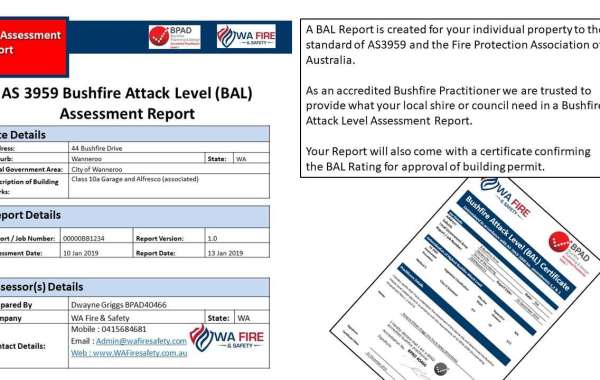This comprehensive guide helps you understand your Bushfire Consultant as you plan to build, extend, or renovate in bushfire-prone areas of Western Australia. Highlighting the importance of correct processes, cost-saving strategies, and how hiring the best BAL assessor can prevent unnecessary headaches and ensure compliance.
What is a BAL Rating?
A BAL (Bushfire Attack Level) rating assesses a Class 1a dwelling or a Class 10a structure associated (within 6m) with a dwelling, like a carport. This measures the building’s potential exposure to ember attack, radiant heat, and direct flame contact during a bushfire. The assessment, expressed in kilowatts per square meter (kW/m²), helps determine appropriate building materials and construction methods to withstand bushfires.
Importance of BAL Ratings in Western Australia
In regions like Perth and other parts of Western Australia, bushfire risks are increasingly significant. BAL ratings ensure structures are built to resist these threats, safeguarding lives and properties. The Western Australian Planning Commission’s State Planning Policy 3.7 (SPP3.7) underscores the need for such assessments to manage bushfire risks effectively.
Understanding BAL Ratings
- BAL-LOW: Insufficient risk. No special construction requirements. Your development will be approved, and a building permit can be issued.
- BAL-12.5: Low risk. Measures to withstand ember attacks and radiant heat up to 12.5 kW/m². Your development will be approved, and a building permit can be issued.
- BAL-19: Moderate risk. Enhanced construction to withstand radiant heat up to 19 kW/m². Your development will be approved, and a building permit can be issued.
- BAL-29: High risk. Significant construction measures to handle radiant heat up to 29 kW/m². Your development will be approved, and a building permit can be issued.
- BAL-40: Very high risk. Measures for strong radiant heat (up to 40 kW/m²) and ember protection. You will need fire mitigation measures prescribed by the bushfire consultant. Additionally, the Local Government Authority will approve these measures, which you should establish at BAL-29 or less. Finally, the bushfire consultant will certify them, ensuring a building permit can be issued.
- BAL-FZ: Flame Zone. Direct flame exposure. You will need fire mitigation measures prescribed by the bushfire consultant. Additionally, the Local Government Authority must approve these measures, which you should establish at BAL-29 or less. Finally, the bushfire consultant must certify them for a building permit to be issued.
How to Conduct a BAL Assessment
A comprehensive BAL assessment involves several critical steps:
- Site Inspection: A BPAD-accredited assessor examines vegetation type, distance to vegetation, and effective slopes under the vegetation.
- Analysis: During the analysis, the assessor will determine the vegetation type, evaluate distances, and assess slope effects on-site. Additionally, they will use computer analysis to ensure accuracy. Mistakes in this stage can be costly, potentially raising your BAL rating.
- Report and Certificate: A detailed report and BAL Certificate are provided, outlining findings and construction requirements. Occasionally, when a site plan is unavailable, the assessor doesn’t issue a report. Instead, we provide a BAL Contour Map, showing the optimal placement for your house to achieve the best BAL rating. We include the report later.
Savings and Benefits of Proper Assessments
Using a BPAD Level 2 Accredited BAL assessor saves money and stress in the long run by utilizing their in-depth understanding of BAL Ratings. Here’s how:
Accurate Assessments
- Avoid extra costs by getting an accurate initial assessment.
- The BAL rating will be correct, specific to your site conditions.
- Avoid the need to change structures or redraw plans.
- Escalate complex sites early to ensure proper solution identification.
- BPAD Level 1 consultants may lack the expertise for complex sites.
Understanding Compliance
- Ensure 100% compliance with local planning policies and SPP3.7.
- Implement appropriate mitigation measures, including water supply, drive way access, and Asset Protection Zones.
- Prevent potential fines, enforced retrofitting, or demolishment.
- Avoid the need to redraw documentation or seek re-approvals.
- Eliminate costly changes and additional consultations.
Construction and Compliance Costs
- Accurate site assessments can lower the overall BAL rating and, as a result, reduce construction expenses.
- Prevent delays from relocating structures, and editing plans.
WA Fire Safety (WAFS), trusted and endorsed by local governments in WA, provides expert BAL assessments. Their BPAD Level 2 Accreditation guarantees good service, handling simple to complex jobs without cutting corners. Learn more about their services and get a quick quote here.
Links to Resources
- FPAA Accredited Practitioners: Find certified practitioners at the FPAA register.
- DFES Bushfire Prone Area Map: Check if your property is in a bushfire-prone area using the DFES map.
BAL Procedure
The BAL procedure involves an in-depth analysis compliant with Western Australia’s guidelines:
- Pre-Assessment Consultation: Engage with your assessor to understand requirements.
- Formal Assessment: Conduct detailed site inspection and analysis.
- Vegetation Management: Modify vegetation as per guidelines to potentially lower the BAL rating.
- Documentation: Submit a comprehensive BAL report, including assessment maps and protective measures.
Conclusion
Understanding your BAL ratings not only ensures compliance and safety but also reduces costs associated with construction.
In Western Australia, where bushfire risks are prevalent, leveraging the expertise of seasoned professionals like WA Fire Safety can make all the difference. For a hassle-free assessment and quick quote, visit WA Fire Safety.
By grasping the intricacies of BAL ratings, you are taking critical steps to protect your property from bushfires. Engage certified professionals to ensure the best outcomes for your building projects.








